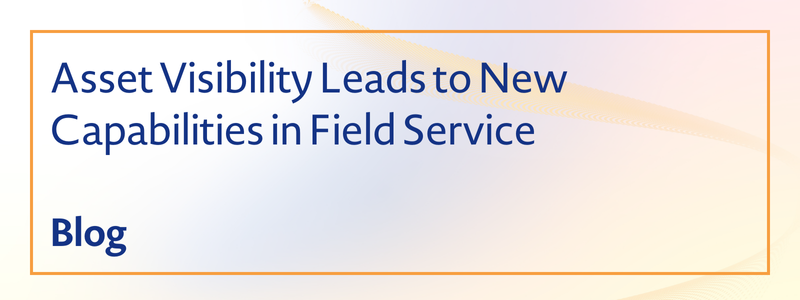Asset Visibility Leads to New Capabilities in Field Service


(Source: Unsplash)
As field service organizations continue their efforts toward digital transformation, new capabilities and service offerings are emerging as a result. Central to these organizations' transformations is a relatively simple concept: asset visibility. By gaining real-time visibility into how their deployed assets are performing, manufacturers, distributors, and field service teams can determine how well their products are serving their customers.
Of course, real-time visibility requires manufacturers to integrate internet of things (IoT) sensors into their products. This technology is central to real-time visibility, but it is becoming more and more accessible to organizations of all sizes.
Here are just a few of the benefits of asset visibility to both field service teams and their customers.
Don't miss new reports! Sign up for The Field Service Newsletter
Real-Time Monitoring and Reporting on Asset Performance
By monitoring deployed assets in real-time, field service organizations can get a bird's eye view of how all their assets are performing in the field. With the right reporting and analytics tools, they can even monitor long-term and short-term trends to identify issues with assets.
These reporting tools can even be shared with customers, granting them enhanced visibility into how their purchased tools and machines are performing. Ideally, this could solve some significant challenges in the field service industry, especially when it comes to customers' understanding of how their equipment works.
With enhanced visibility, it can be easier for field service teams and customers to identify and diagnose problems before they lead to asset downtime.
Automating Maintenance Schedules
These reporting and analytics capabilities can be paired with artificial intelligence (AI) to reduce or remove manual maintenance scheduling tasks. Instead of humans analyzing asset data to spot trends, and AI can automatically generate reports, orders, and maintenance requests.
These requests can then be pushed directly to field service teams and technicians that are already in the field. Field service organizations that work with contractors can even provide them with the same tools as their in-house technicians, enabling them to take maintenance calls as they are generated.
More First Time Fixes
Hopefully, enhanced visibility can help field service teams automate preventive maintenance so that customers can rely on their machines' uptime. But this isn't always the case. Sometimes, machines break down.
When this happens, they must be fixed quickly, the first time. This has been the golden rule of field service for years. Thankfully, enhanced asset visibility makes first-time fixes much easier. That's because field service technicians can enter the field with data collected remotely from the assets they are going to fix.
With the right reporting tools, field service technicians should already know the problem before they ever arrive on-site. They'll be properly equipped with the tools, parts, and replacements they need to deal with the problem, so the customer can get up and running much faster.
Transitioning from Maintenance Warranties to Outcome-Based Contracts
New service capabilities are only a part of the benefits provided by asset visibility. When executed properly, asset visibility allows service providers to launch new and more competitive product offerings for their customers. Instead of selling machines and other assets accompanied by a service package, field service organizations can instead sell outcomes.
This is the outcome-based service model, and it is quickly becoming the gold standard for field service organizations.

According to a recent survey by Salesforce, distributors and manufacturers are already transitioning from a break-fix service model to an outcome-based service model—51% of respondents to the study say they are "entirely aligned with this strategy." Another 45% say they are "somewhat aligned with this strategy."
The key benefit of outcome-based service is that it can improve relationships with customers and improve customer retention. Customers that are guaranteed a certain level of uptime for the assets they purchase are more likely to stay with the organization, especially if competitors can only offer to fix an asset once it breaks down.
Furthermore, the outcome-based model shows customers that the manufacturer, distributor, or asset provider is invested in their success. Instead of a service warranty, customers can trust that their partner will take all necessary steps to ensure they are operating at full capacity.
Naturally, the outcome-based field service model isn't possible without asset visibility. By integrating assets with sensors, wireless connectivity, and even digital twin technology, manufacturers and service providers can get a real-time view of asset performance, create automated alerts, and ensure assets are always in working order.
Don't Miss the Next Field Service Event
There is a sea change occurring in the field service field. Manufacturers, distributors, and other organizations that sell and manage deployable assets like machines are shifting from a break-fix model of customer service to a new, more streamlined outcome-based model.
To achieve this transition, organizations must be able to deploy IoT sensors, software, and other technologies to obtain full visibility into their deployed assets.
These and other topics are likely to be hot topics at the next event in the Field Service conference series. Contact us to learn more.